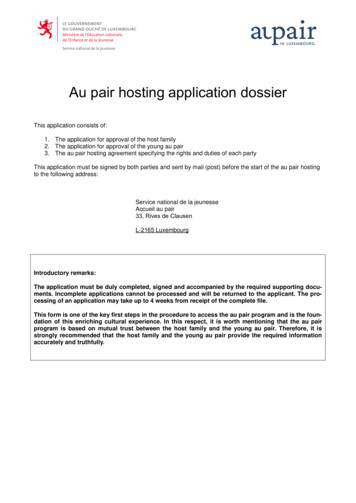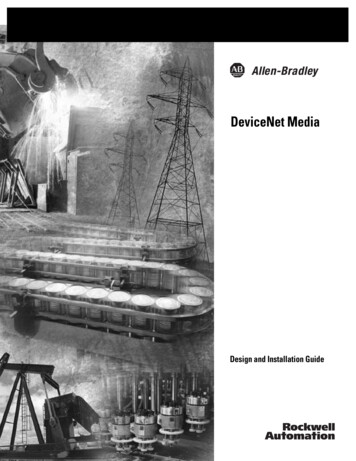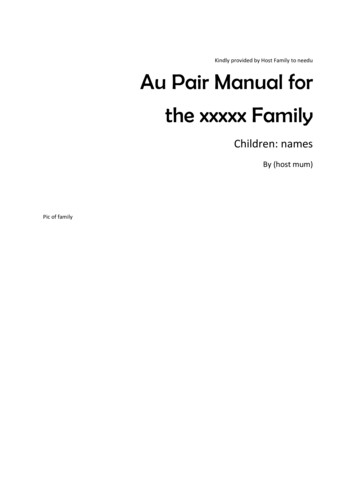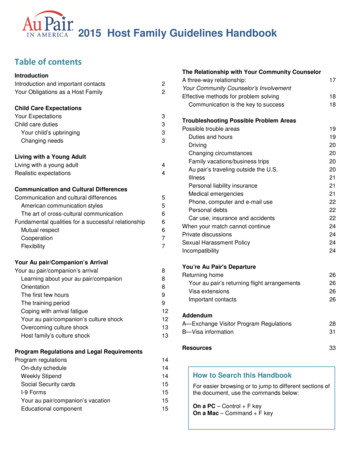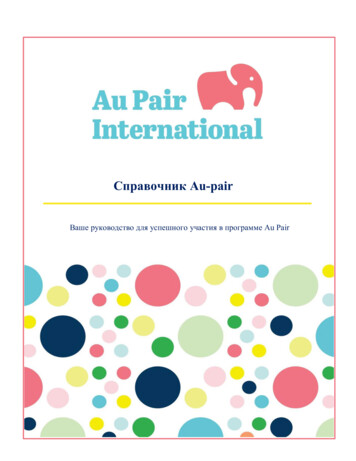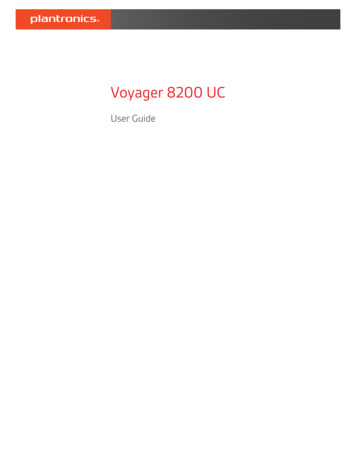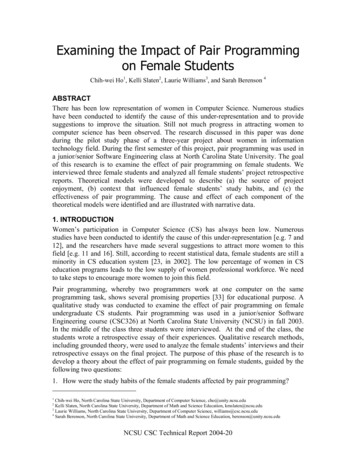
Transcription
Examining the Impact of Pair Programmingon Female StudentsChih-wei Ho1, Kelli Slaten2, Laurie Williams3, and Sarah Berenson 4ABSTRACTThere has been low representation of women in Computer Science. Numerous studieshave been conducted to identify the cause of this under-representation and to providesuggestions to improve the situation. Still not much progress in attracting women tocomputer science has been observed. The research discussed in this paper was doneduring the pilot study phase of a three-year project about women in informationtechnology field. During the first semester of this project, pair programming was used ina junior/senior Software Engineering class at North Carolina State University. The goalof this research is to examine the effect of pair programming on female students. Weinterviewed three female students and analyzed all female students’ project retrospectivereports. Theoretical models were developed to describe (a) the source of projectenjoyment, (b) context that influenced female students’ study habits, and (c) theeffectiveness of pair programming. The cause and effect of each component of thetheoretical models were identified and are illustrated with narrative data.1. INTRODUCTIONWomen’s participation in Computer Science (CS) has always been low. Numerousstudies have been conducted to identify the cause of this under-representation [e.g. 7 and12], and the researchers have made several suggestions to attract more women to thisfield [e.g. 11 and 16]. Still, according to recent statistical data, female students are still aminority in CS education system [23, in 2002]. The low percentage of women in CSeducation programs leads to the low supply of women professional workforce. We needto take steps to encourage more women to join this field.Pair programming, whereby two programmers work at one computer on the sameprogramming task, shows several promising properties [33] for educational purpose. Aqualitative study was conducted to examine the effect of pair programming on femaleundergraduate CS students. Pair programming was used in a junior/senior SoftwareEngineering course (CSC326) at North Carolina State University (NCSU) in fall 2003.In the middle of the class three students were interviewed. At the end of the class, thestudents wrote a retrospective essay of their experiences. Qualitative research methods,including grounded theory, were used to analyze the female students’ interviews and theirretrospective essays on the final project. The purpose of this phase of the research is todevelop a theory about the effect of pair programming on female students, guided by thefollowing two questions:1. How were the study habits of the female students affected by pair programming?1Chih-wei Ho, North Carolina State University, Department of Computer Science, cho@unity.ncsu.eduKelli Slaten, North Carolina State University, Department of Math and Science Education, kmslaten@ncsu.edu3Laurie Williams, North Carolina State University, Department of Computer Science, williams@csc.ncsu.edu4Sarah Berenson, North Carolina State University, Department of Math and Science Education, berenson@unity.ncsu.edu2NCSU CSC Technical Report 2004-20
2. How and why did the female students like (or dislike) pair programming?The rest of this paper is organized as follows. Section 2 provides prior studies aboutgender issues and pair programming, as well as the research method utilized in thisresearch. Section 3 gives a detailed description about the research approach, and Section4 presents the research results. Finally, Section 5 concludes the paper and suggests futurework.2. BACKGROUNDIn this section, I will present a literature review of studies about gender issues in the fieldof CS. Then, I will discuss the background of pair programming and its applicability in aclassroom setting. Finally, information about the research method used in this study willbe provided.2.1. Women in Computer ScienceThere has been an ongoing concern about the low representation of women in the field ofCS. Statistics shows that women are under-represented in academic CS, as shown inFigure 1. The graph shows the percentages of post-secondary degrees conferred to femaleCS students by degree-granting institutions from 1988 to 2001 [calculated from 23].From the graph, we can see that the percentages of female CS bachelor and mastersdegree receivers have been consistently around 30% in the last decade, and thepercentage of female CS doctoral degree receiver is even lower.40353025Bachelor20MasterDoctoral15105088-89 89-90 90-91 91-92 92-93 93-94 94-95 95-96 96-97 97-98 98-99 99-00 00-01Figure 1: Female percentage of post secondary degrees in Computer and Information ScienceFor the purpose of comparison, Figure 2 shows the percentages of secondary degrees inall fields [calculated from 23, in 1990-2002] conferred to female students. The graphshows that there are increasing percentages of female degree receivers, an opposing trendto what is seen in CS. While approximately 50% of post-secondary degrees were awardedto women, female participation in CS has been low. Nevertheless, women’s participationis important. Cohoon [12] emphasizes some reasons why we need participation of womenin CS, including maintaining a supply for CS professionals, providing diverse viewpoints,and promoting gender equity. Actions must be taken to attract more women to CS field.NCSU CSC Technical Report 2004-20
706560Bachelor55Master50Doctoral4540353088-89 89-90 90-91 91-92 92-93 93-94 94-95 95-96 96-97 97-98 98-99 99-00 00-01Figure 2: Female percentage of post secondary degrees in all fields.Camp describes a pipeline shrinking problem concerning women in CS [9]. Camp notesthat although 50% of high school CS classes were made up with women in 1993 – 1994,only 28.4% of the bachelor’s degrees in CS were awarded to women. The number wenteven lower with graduate degrees: 25.4% at the master’s level, and 15.4% at the doctorallevel. Camp contends that computer scientists and educators have not done enough tomake progress and that dramatic change needs to be taken. From the recent statistics datafrom National Center for Education Statistics, we can see that the pipeline is stillshrinking today [23, in 2002]. A consequence of the low number doctoral degree in CSreceived by women is the low number of female faculty. According to the CRA Taulbeesurvey, fewer than 20% of newly hired faculties in year 2001-2002 were female [29]. Thelack of female faculty results in the lack of CS role models for female students, which isreported as one of the reasons why girls do not pursue CS careers [16]. It is necessary toimprove women’s retention in CS education to balance representation of differentgenders.Researchers have shown that men and women have different passions and interests inlearning. Margolis et al. [20] point out that female students in CS are more interested inbroader, people-oriented issues, and male students like CS because of their fascinationwith the machine. A survey of 567 first-year college students shows that female studentsare significantly more interpersonally-oriented, career-oriented, and family-orientedwhen compared with male students [6]. However, computing is widely stereotyped as asolitary, masculine activity. CS students are perceived to be very smart, spending theirdays working alone in front of the computer and talking about nothing but computerscience [19]. The impression of this field is discouraging to female students.Lack of confidence is also a reason that women stay away from CS. Beyer et al. indicatethat women have less confidence in their computer capability [7]. Bayer conducted asurvey of 56 students (24 females and 32 males) enrolled in a CS course at the Universityof Wisconsin-Parkside. The survey results indicate that although men and womenthought male students outperform female students in CS, females CS students actuallyNCSU CSC Technical Report 2004-20
have a higher GPA [5]. That men can do better in “masculine” majors is a misconception,but it also dispirits women from joining CS at the first place.To address the problems, the American Association of University Women EducationalFoundation Commission on Technology, Gender, and Teacher Education performed asurvey of 900 teachers and qualitative research with more than 70 girls [1]. In the report,the commission makes several key recommendations for schools. The recommendationsinclude the following:-School software should not be specially designed for boys or girls.Provide positive role models.Change the negative stereotype of computing as a solitary activity.Engage girls in the “tinkering” activities of computing to stimulate deeper interest intechnology.Design classroom activities for gender equity. Design group work and encouragemultiple approaches for learning.2.2. Pair Programming and Its Effectiveness in EducationPair programming is a practice, whereby two programmers work side by side at the samecomputer, continuously collaborating on the same design, algorithm, code, or test [33].One of the programmers is the driver, who has the control of the keyboard and the mouse,actively implements the program, and explains the implementation to his or her partner.The other is the navigator, who constantly watches the driver, reviewing driver’s design,detecting driver’s errors, and being a brainstorming partner. After a period of time(usually less than one hour), the programmers switch their roles. Pair programming hasbeen practiced for a long time and has recently been popularized by ExtremeProgramming [3], an emerging software development method. Early evidence for theeffectiveness of pair programming was only anecdotal. Recent researches find that pairprogrammers can produce code with higher quality without sacrifice of productivity [10].Williams and Kessler point out seven behaviors that happen naturally when programmingin pairs [33]. These behaviors make it possible for pair programmers to finish their tasksabout twice as fast as solo programmers, with the use of approximately the same overallresource expenditure, and still generate higher quality products. These seven behaviorsare:1. Pair pressure: Williams and Kessler report that, in a junior-senior softwaredevelopment course, most students worked harder when paired because they did notwant to let their partners down [31]. The students do not intentionally put pressure ontheir partners. Nevertheless, each feels the push to move forward.2. Pair negotiation: The two programmers work together to solve a problem. They havedifferent prior experiences but a common goal. The two have to negotiate to share acommon approach.3. Pair courage: The programmers give each other the courage to do something theymight not do if working alone.4. Pair learning: The programmers can learn from their partners’ continual critique andreview. Additionally, because the programmers work closely together, theirNCSU CSC Technical Report 2004-20
knowledge, including programming tips, design skills, tool usage, is transferredbetween them constantly.5. Pair trust: Pair programmers work in a collaborative fashion. They learn to trust theirpartners to get the work done.6. Pair review: When working in a pair, both programmers review their joint productcontinuously. This review technique has been shown effective and enjoyable.7. Pair debugging: Debugging is a tedious and laborious task. However, if we candiscuss the problem with someone, we might find new ideas and solutions.Because of the promising properties of pair programming, some educators started using itin the classroom. Research conducted at the University of Wales indicates that studentswith low self-confidence seem to enjoy pair programming most, while students who thinkthey have high skill level like to pair the least, especially when they have to work withstudents with less confidence [28]. Although the authors did not distinguish the students’attitude from their real performance in this research, it still shows that students with highconfidence usually regard themselves as “lone rangers.” However, another study done atNCSU indicates that the association between the self-esteem and the compatibility of pairprogrammers in a classroom is weak [18]. The difference may result from the inaccuracyof the students’ self measurement of self-esteem.Research conducted at University of California at Santa Cruz (UCSC) and NCSU haveshown the effectiveness of pair programming in introductory CS courses [21, 22, 34].Their studies show that paired students achieve higher performance and produce higherquality code. Furthermore, those studies also show that pair programming helps studentpersistence in computer science related majors. Sanders indicates that students who favorfor pair programming think it enhances their learning experience, while those opposed toit think pair programming can pull back good programmers and should be practiced onlywith competent partners [25]. These studies about pair programming show that pairprogramming is a promising approach for computer science educators to use with theirstudents. However, we need to explore the variety of students’ responses to enhance thestudents’ learning experience.2.3. Qualitative ResearchQualitative research is widely used in the fields of education, nursing, sociology, andpsychology, to explore the complexity of social or human problems. Denzin and Lincolndescribe qualitative research as “multimethod in focus, involving an interpretive,naturalistic approach to its subject matter.” To perform qualitative research, theresearchers need to “study things in their natural settings, attempting to make sense of orinterpret phenomena in terms of the meanings people bring to them.” [14] The intent ofour study is to examine the effects of different programming practices among the femalestudents in an undergraduate level Software Engineering course. It is not possible tomeasure students’ behaviors using quantified measurements without losing the accuracyof the meaning. Therefore, qualitative methods are used in this study. Two qualitativedata collection methods are used:1. Interview: In qualitative research, interviews usually involve unstructured and openended questions. The intent of interviews is to elicit views and opinions from theinterviewees [13].NCSU CSC Technical Report 2004-20
2. Document: Another source of qualitative data can be text in documents. Documentsoffer data that are more thoughtful than interview, because the participants can givemore attention when writing a document. However, if the documents are not in astructured format, the researcher may need to make an effort to find useful information.[13]Qualitative data can be analyzed via a technique called coding. Some qualitative data,especially more structural ones, can be quantified so statistical methods can be applied.Seaman recommends several coding methods for studies utilizing mixed (quantitative andqualitative) approaches [26]. In Seaman’s definition, coding is the process of turningqualitative data into quantitative data. The quantifying process usually results in loss ofinformation. However, the quantified data are more reliably accurate when they arerestricted to “straightforward, objective information.”2.4. Grounded TheoryThe majority of the data used in this research cannot be quantified. To preserve thecomplexity of the data, a qualitative research approach called grounded theory is used.Grounded theory was first described by Glaser and Strauss [15]. The spirit of groundedtheory is that the theories can emerge from gathered data, in contrast to research in whichdata is gathered to support or refute a theory. The intent is to generate or discover atheory that is “grounded” in data from the field. In grounded theory, new theory comesfrom a small size of cases, exploring a wide variety of variables. This approach is suitablefor this research because the impact of pair programming on female students is unclear.Strauss and Corbin define a coding procedure for grounded theory [27]. Note that codingin this context is different from Seaman’s definition. Here coding is the process thatattaches labels to different categories (or themes). Strauss and Corbin define theory as aset of interrelated, well-developed categories. The interrelationships among the categoriesform a theoretical framework that explains the phenomenon existing in the collected data.The proposed coding procedure has three steps: open coding, axial coding, and selectivecoding. Open coding is the process of identifying the categories in the data and theproperties of the different categories. Axial coding is used to connect the categories andto find their interrelationships. In the last step, selective coding identifies one or twocentral categories and forms a conceptual framework from which to generate a theory.Strauss and Corbin’s coding process is utilized in analyzing the qualitative data in thisresearch to examine the effect of pair programming on female students.3. RESEARCH APPROACHThe focus of this research is to find out the female students’ response to pairprogramming pedagogy. There are two questions guiding the research:1. How were the study habits of the students affected by pair programming?2. How and why did the students like (or dislike) pair programming?We care more about the female students’ feelings of and reaction to pair programming,than about their performance in the class. The objective of this research is to find agrounded theory of the effect of pair programming on female students. This sectionprovides the parameters and methods of the research.NCSU CSC Technical Report 2004-20
3.1. Research SettingsThis research was during the pilot study phase of a three-year project about women in theinformation technology field. A study was run at NCSU in the 2003 fall semester with anundergraduate-level Software Engineering course (CSC326). There were 103 students inthe class, including 16 (15.5%) females and 87 (84.5%) males. Ninety-three students,including 15 (16.1%) females and 78 (84.0%) males, agreed to participate in this researchby signing an Institutional Review Board Informed Consent form. In this paper, only datafrom participating students are analyzed. Table 1 shows the GPA information of thestudents. Note that the female students had a higher overall GPA than the male students;however, their CS GPA was lower.Table 1: Students’ GPA information5FemaleMaleAllGPA Average3.253.173.18Std. Deviation0.500.540.53CS GPA3.063.233.21Std. Deviation0.700.670.67The course in which the study took place was a three-credit junior-senior SoftwareEngineering course. The students had two 50-minute lectures each week. Additionally,the students were divided to five lab sections of approximate 24 students per section, ledby a student lab instructor. The students had three programming assignments, the firsttwo of which were paired assignments. For the paired assignments, each student wasassigned a partner. A different partner may be assigned for each assignment. After thethree programming assignments, there was also a final project, in which the studentsworked in groups of between four and five students to write a plug-in for Eclipse6, anopen-source development environment for the Java programming language.To allow for comparison for our research, there were two types of groups for the teamproject: solo groups and paired groups. In the solo groups, each team member wasassigned a piece of the overall project, programmed alone and integrated completed work.In paired groups, the members practiced pair programming, where the team was dividedinto pairs, and each programming task was assigned pair-wise. The students might switchtheir pairing partners during the development.To assign the students with groups of their favorable programming styles, they wereasked to submit a short paper which provided their choice of programming style (solo,paired, or don’t care), a short statement of their rationale for making this choice, and tolist the students she or he did not want to work with. The students’ preference ofprogramming is shown in Table 2. For the most part, a student was assigned to a group ofher/his programming style. More than half the students preferred to work in pairs. Toallocate approximately the same number of students in both programming styles, thestudents who did not care for the programming style were initially assigned to sologroups. Additionally, prior academic performance was considered so that the groupscould be as academically equivalent as possible. Finally, programming style assignmentwas adjusted to conform to the following rules:56Two females did not have GPA information; one male did not have GPA information; three females didnot have major GPA information; and three males did not have major GPA information.http://www.eclipse.orgNCSU CSC Technical Report 2004-20
1. A group could only have students of the same lab section. Therefore, if few studentsin a lab section chose a certain programming style, some students in the same labsection would need to change their programming style so that the number of studentsin a group could be either four or five.2. The number of students in paired groups should be similar to that of students in sologroups.3. The academic performance (see below) of students in paired groups should be similarto that of students in solo groups.4. If a group had any female member, there should be at least two female members inthe group.The academic performance is an aggregated score based on the student’s SAT-Math(SATM), overall GPA, and the midterm score of the course. It is evaluated with thefollowing algorithm. In the algorithm, NSAT is normalized SATM score (SATM scoredivided by eight), and NGPA is normalized GPA score (GPA score multiplied by 25).The normalization is necessary so that all three scores (normalized SATM, normalizedGPA, and midterm score) range from 0 to 100.NSAT SATMScore / 8NGPA GPA * 25if SAT and GPA are unavailable thenperformance MidtermScoreelse if SAT is unavailable thenperformance MidtermScore * 0.5 NGPA * 0.5else if GPA is unavailable thenperformance MidtermScore * 0.5 NSAT * 0.5elseperformance MidtermScore * 0.4 (NGPA NSAT) * 0.3endifThe students were not enforced to use the assigned programming style, though. Thepurpose of programming style assignment was to gather students of similar preferencetogether so that they could use their preferred style.After the programming style of each student had been decided, the students wereassigned to different groups randomly. However, their lists of “undesirable partners”were taken into consideration. Table 2 shows the result of programming style assignment.Table 2: Programming Style AssignmentFemaleMaleAllPreferred StyleSoloPairedDon’t Care582164418215220Assigned StyleSoloPaired8738404647Table 3 shows the students’ academic performance scores regarding of the assignedprogramming styles, indicating the groups were essentially equivalent academically.Table 3: Students’ Performance ScoresSoloAverageStd. Deviation77.5111.11PairedAverageStd. Deviation76.6510.11NCSU CSC Technical Report 2004-20
3.2. Limitations of StudyA number of limitations of this study need to be taken into consideration. First is thesmall size of subjects. Only three interviews and 15 retrospective reports of the studentsin the same class were analyzed. Although sample size is not a concern when generatinga theory [15], the small sample size made it inappropriate to utilize statistical methods onthe quantitative data so triangulated results [17] could be found. Additionally, generalitycannot be shown in this study due to small sample size and sample similarity. Furtherstudy, as described in Section 5, will be conducted to confirm the findings in this research.3.3. Research MethodsTo attain accuracy and breadth of the result, both quantitative and qualitative methodswere applied. Data collection and analysis approaches are explained in this section.3.2.1. Data CollectionThe information about students’ academic performance is used. The information includestheir GPA scores, assignment scores, and the final scores of the class.There are two sources of qualitative data used in this study. One is the interviews withseven students, including three females, in the middle of the semester. The interviewswere conducted and transcribed by Berenson and Slaten from the Department of MathEducation [4]. These interviews were semi-structured. The interview protocol is providedin the Appendix A. The interview data of the female students are analyzed in this paper.The other source is the students’ project retrospectives. At the end of the semester, thestudents were asked to write two-page project retrospectives. The project retrospective isin the form of a questionnaire, including several yes/no questions and several open-endedones. The questionnaire used to structure the project retrospectives is provided inAppendix B. In this paper, the retrospectives of 13 female women are analyzed.3.2.2. Data AnalysisThe focus of this paper is to form theories from the data we collected. In this research,there are large amounts of qualitative data. In the project retrospectives, some questionsare more objective and concrete. The students’ answers to these questions are quantified.The quantified information is not the focus of this study, but it is used with qualitativedata to study the same phenomenon [17]. The quantifying coding process is not suitablefor the analysis of the student interviews and the open-ended questions in theretrospectives. Grounded theory was used to analyze those less-structured data.In addition to quantifiable data such as GPA and course grades, the students’ attitudesand feelings about software development are the center of this research. The interviewsare the most informative data for this purpose. The coding process applied in thisresearch is described as follows.Open coding. The interviews with female students consist of approximately 30 pages oftextual data. In the open coding process, the categories for each interview were identified.The result of open coding is written in pairs in the form of category, excerpt . Eachcategory is labeled with a short noun. An example is given as follows.NCSU CSC Technical Report 2004-20
Category Sense of dependencyExcerpt Especially after you’ve done two pair programming assignments and whenyou go back to the old style of doing solo, it kind of feels a little bit hard. Itsuddenly feels like that the weight is heavier like you have to do all this stuffon your own and there’s nobody to talk to and to ask a question to.Open coding helps highlight the points in the unstructured textual data. After this process,the female students’ interview was reduced to approximately five pages of morestructured textual information. Additionally, the categories were clearly identified.Axial coding. After the categories were identified via open coding, we performedadditional analysis to find the interrelationships among the categories.Theinterrelationships were represented as cognitive maps [24]. For example, Figure 3demonstrates the result of axial coding in the previous example.Figure 3: Categories InterrelationshipsIn the diagram, each block is a category. A solid arrow is a positive relationship, and adashed arrow is a negative relationship. In this example, the diagram shows that, in thecase of this student, pair programming increased her sense of dependency, which madeher think solo programming was difficult.Selective coding. The axial coding resulted in several tangible diagrams. In selectivecoding, the focus was on finding the categories of interest and on determining if somepatterns can emerge about these categories. If such patterns can be found, we can form atheory based on such patterns. For example, from the cognitive map in Figure 3, we canform the proposition:The student learns to depend on the partner after getting used to pair programming.However, this sense of dependency makes it difficult for the student to program alone.Sometimes we cannot find recurring patterns. If this happens maybe some categories aremissed out, or the patterns cannot form a theory. In the prior case, we need to go back tothe original data to find out new categories or go back to the field to find out newevidence.4. RESULTSIn this section, the results will be presented, grouped by the categories of interest. Threecentral categories are shown: enjoyment, study habits, and pair programmingeffectiveness. Based on the interviews and project retrospectives, the factors affectingeach of the main categories will be discussed.NCSU CSC Technical Report 2004-20
4.1. EnjoymentWhat aspects of software development interest girls? In his classical book The MythicalMan-Month, Brooks lists the joys of programming [8]. They are: the joy of making things;the pleasure of making things that are useful to other people; the fascination of fashioningcomplex parts and watching them work in subtle cycles; the joy of learning; and thedelight of working in a tractable medium. The final project of this course has all thesefive properties: it is about making a useful software tool; composing several softwareparts; learning new framework for a development environment; and working in atractable medium. Did the female students enjoy the term project because of theseproperties? Are there other factors of enjoyment in a team project?In the retrospective, the students were asked whether they enjoyed the project. Figure 4shows the cognitive map from the female students’ response. Four out of seven femalestudents in solo groups and three out of six female students in paired groups said theyenjoy the project.Figure 4: Project Enjoyment Cognitive MapAlthough earlier studies have shown that paired students have higher level of enjoymentthan solo students [21], the female students in t
1. How were the study habits of the female students affected by pair programming? 1 Chih-wei Ho, North Carolina State University, Department of Computer Science, cho@unity.ncsu.edu 2 Kelli Slaten, North Carolina State University, Department of Math and Science Education, kmslaten@ncsu.edu


